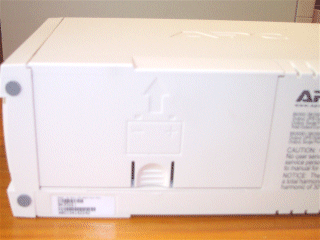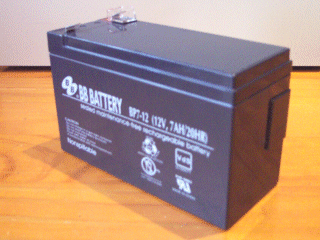|
|
|
|
Date: |
October
6th, 2001 |
| Type: |
Review |
| Supplier: |
APC
|
| Author: |
mayhem |
| RRP: |
$221
AUS ($315 AUS for Back-UPS CS 500 model) |
|
Testing
When you are happy that the system is setup the way you want it
(for a server you would run the cable modem or equivalent and the
machine itself, whereas a client machine you would run the machine
and the monitor) then you might want to test how long the UPS lasts
on the standard system load (i.e. typical amount of CPU usage by
the programs you usually run).
The best way
of testing the unit is to simple disconnect the power source it
is plugged into, you can do this in either of two ways, the first
by simply turning it off at the power point, the other is pulling
the plug out of the wall.
The following is
our test information:
- 1. System
(tower only) with WinAmp (MP3's) playing, UPS lasted: 00:43:01:33
(43 min and 1 sec).
- 2. System
idle (no additional software) with Monitor and Cable Modem attached,
UPS lasted: 00:14:13:81 (14 min and 13 sec).
- 3. System
at full load (above normal usage) with Monitor and Cable Modem,
UPS lasted: 00:09:57:48 (9 min and 57 sec).
- 4. System
at average/normal load (with Cable Modem attached), UPS lasted:
00:38:31:73 (38 min and 73 sec).
Overall the
unit lasted for an average of 26 minutes and 25 seconds
(00:26:25:59) , this is quite decent for a UPS of this size,
seeing as it only runs on one sealed lead acid battery which has
a rating of 7Ah at 12V it is rather impressive. We tried to simulate
the most common setups, Client, Server, Normal Machine etc. to give
the best overall readings of how long the unit lasted, it took 6
hours approximately between tests to recharge the battery.
All of the above
testing was done with the Power Schemes turned to "Never",
Low Battery warning set to 25% and Hibernation set to 5%, this way
we would use 95% of the battery life to get the above readings.
The system used was a Pentium 2 450MHz with 192MB Memory, 30G Seagate
7200RPM Hard Disk and multiple expansion cards etc, the monitor
was a 17" Mitsubishi Diamond View.
The recommended
setup would be to connect the system (server or client tower) and
your cable modem to the battery backup ports on the UPS, as for
the monitor it is best to only connect this to the surge protection
as the monitor drains power quickly from the UPS, you may also like
to play with the settings so that the system hibernates later than
the default time, this would be so that the system stays on until
the battery has life 10% (or so), this all depends on the average
amount of time the power is out in your area.
Status Indicators
and Alarms
There are four status indicators (lights) on the front panel of
the Back-UPS (On Line, On Battery, Overload, and Replace Battery).

 |
On
Line (green) - is lit whenever utility power is powering
the Battery Backup outlets. |
 |
On
Battery (yellow) - is lit whenever the battery of the Back-UPS
is powering the equipment connected to the Battery Backup Outlets. |
 |
Four
Beeps Every 30 Seconds - this alarm is sounded whenever
the Back-UPS is running On Battery. Consider saving work in
progress. |
 |
Continuous
Beeping - this alarm is sounded whenever a low battery condition
is reached. Battery run-time is very low. Promptly save any
work in progress and exit all open applications. Shutdown the
operating system, computer and the Back-UPS. |
 |
Overload
(red) - is lit whenever power demand has exceeded the capacity
of the Back-UPS. |
 |
Continuous
Tone - this alarm is sounded whenever the Battery Backup
outlets are overloaded. |
 |
Circuit
Breaker - the circuit breaker button located on the read
panel of the Back-UPS will stick out if any overload condition
forces the Backup-UPS to disconnect itself from utility power.
If the button sticks out, disconnect non-essential equipment.
Reset the circuit breaker by pushing the button inward. |
 |
Replace
Battery (red) - is lit whenever the battery is nearing the
end of its useful life, or if the battery is not connected (see
above). A battery that is near the end of its useful life has
insufficient run-time and should be replaced. |
 |
Chirps
for 1 Minute Every 5 Hours - this alarm is sounded whenever
the battery has failed the automatic diagnostic test. |
You will probably
notice that if your power fluctuates then the UPS will switch to battery
and then back to mains every now and then, this will also produce a beep
or two, the main reason for this is that the CS line is aimed for the
budget end of the market and it doesn't have the capability to "boost"
power when its fluctuating, other more expensive models have this feature.
Replacing
The Battery
After what you hope will be many years the battery in the UPS might
start to deteriorate in quality, you will notice that the length
of time the UPS can keep your machine on will drop and the UPS itself
will tell you when the battery needs to be replaced. To do so you
will need to place the unit on its side and slide the battery compartment
cover upward and off the UPS.


Next you will
need to pull the battery out, exposing the battery terminals and
wires, disconnect the wires from the terminals.

Now you will
need to slide the new battery into the battery compartment. Connect
the battery wires to the terminals as follows: BLACK wire
to Ground (-) terminal and RED
wire to Positive (+) terminal. You will find the part number of
the replacement battery in the table of specifications of the unit
(see the beginning of this review).


Conclusion
After testing the unit and running a machine on it for just over
a week you can really see the added benefit it would have for critical
computers or those who need a machine to be running when the power
is out. Mainly designed for business's and offices this might not
be practical for home based solutions, but it would sure come in
handy.

Some of the main
features and style of this unit make it very appealing, the quality construction
and USB interface make it very simple and the size of the unit allows
it to be easily placed where every necessary (this could be on top of
a machine to hidden away - see above picture for size against a Midi Tower
ATX case). Seeing as this unit only lasts for approx. 26.5 minutes,
this is good for small solutions, but for large (long) black out areas
this might not be useful, luckily APC also have a wide range of other
UPS solutions so you can always pick the exact one that meets your needs,
although for a Home situation of a Linuxbox and Cable Modem this is an
ideal product at $221.
The only main downside
that I can see from this particular model is the fact that it can't make
up for a fluctuating power source, but this doesn't really make too much
of a concern. It is a little annoying to have to mail away for the additional
Serial cable, but its well worth it as you can then use it on just about
any machine with almost any Operating System.
I would like
to say a big thank you to Jason Rylands from APC Australia and Edwina
Priest from Text 100 Public Relations for providing this new model
UPS for review so quickly after its release.
Score:
8.5 / 10
FORUM: Talk
about this and other products
|

